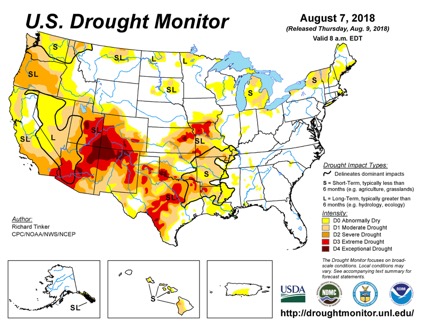We need water for a variety of uses, but chief among them is to grow food. Seventy-one percent of water consumed globally is poured into crop and livestock production. Yet many agricultural producers live in water-stressed areas and the problem is growing worse.
By some projections, over half of the world’s population will be at risk for water scarcity by 2050—a time when water needs for agricultural production will have grown over 20 percent. The mismatch puts as much as 39 percent of cereal production and 49 percent of global grain production at risk due to water stress according to a new report by the Chicago Council on Global Affairs, From Scarcity to Security: Managing Water for a Nutritious Food Future.
While the United States has ample water resources compared to many other countries around the world, we are not immune to weather vagaries that threaten harvests. Just last August, many areas from the Midwest to Western United States were experiencing abnormally dry to extreme drought conditions. The infamous US drought of 2012 affected the majority of the country and was responsible for major crop failures.
 Demand for food is growing in line with population growth, rising incomes, and migration to cities. Farmers worldwide need adequate water supplies to reliably produce and trade diverse, micronutrient-rich foods such as fruits, vegetables, animal-source proteins, and dry season crops that might include squash and beans. With diminishing availability of arable land, farmers must continually improve yields, which drives intensification of agricultural production around the world.
Demand for food is growing in line with population growth, rising incomes, and migration to cities. Farmers worldwide need adequate water supplies to reliably produce and trade diverse, micronutrient-rich foods such as fruits, vegetables, animal-source proteins, and dry season crops that might include squash and beans. With diminishing availability of arable land, farmers must continually improve yields, which drives intensification of agricultural production around the world.
That's why researchers, farmers, and policymakers are deploying a variety of “more crop per drop” solutions which run the gamut from low-tech, low-cost solar-powered irrigation pumps to more sophisticated data techniques. Even the high-tech approaches are becoming accessible to small farmers everywhere. Any size tractor can be equipped with GPS to help farmers monitor and conserve applications of critical inputs, saving them money while protecting their soil. Healthy soil is more fertile, soaking up rainwater and holding nutrients.
Furthermore, communities must improve governance to better manage withdrawals for municipal, industrial, and agricultural uses, along with watershed-level planning to ensure water security into the future.
The Nature Conservancy is even trying out innovative financial approaches, using investment capital to purchase water through markets and then leasing or selling water rights back on the market to farmers and cities, while diverting some of the water back to natural ecosystems. Water trading is already commonly used in Australia, and The Nature Conservancy is currently looking into the feasibility of implementing it in the Western United States. Particularly in regions where water is scarce, exploring new market-based approaches will help get the pricing of water right, which both discourages wasteful or overuse of water and ultimately reduces costs for users such as farmers.
We are lucky that our farmers grow a surplus of food, earning critical revenue from global exports while helping to feed the world. Global trade in agricultural products moves food from where it can be efficiently produced to where it will be consumed, helping millions around the world gain access to more diverse, nutrient-rich diets and stave off food insecurity. But food needs water to grow, making better water management critical to support today's food demand while ensuring the ability to expand global trade in food.
Andrea Durkin is the Editor-in-Chief of TradeVistas and Founder of Sparkplug, LLC. She is a nonresident Senior Fellow at the Chicago Council on Global Affairs.
Editor's Note:Agri-Pulse and The Chicago Council on Global Affairs are teaming up to host a monthly column to explore how the US agriculture and food sector can maintain its competitive edge and advance food security in an increasingly integrated and dynamic world.

